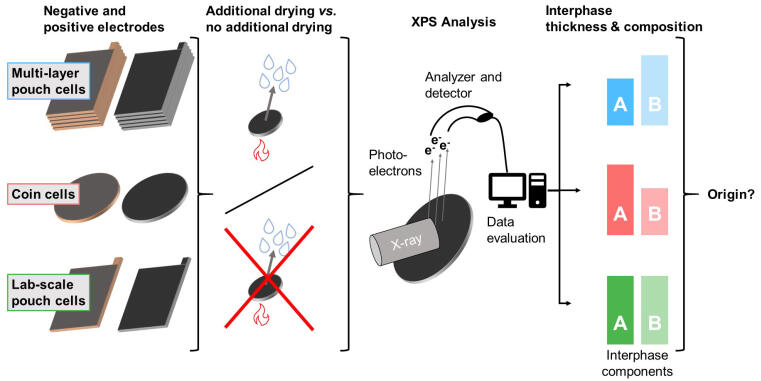Interphase Comparability of Different Lithium-Ion Cell Formats Investigated
A decisive factor for the performance of lithium-ion batteries are the solid electrolyte interphase (SEI) and the cathode electrolyte interphase (CEI). A team of MEET Battery Research Center at the University of Münster has investigated and compared the interphases at the electrodes of three different cell formats with X-Ray Photoelectron Spectroscopy (XPS). The scientists demonstrated that even small amounts of water had a large impact on the chemical composition and thickness of the interphases, which are critical for battery performance. Results show further that the cell housing has notable influence on the water content of the cells.
Even Minimal Water Content Influences Measurement Results
All work was performed in a dry room to ensure that the atmosphere was as water-free as possible – since the chemistry in lithium-ion battery cells is extremely sensitive to water. But even working in a dry room cannot exclude minor water contaminations. “We were able to determine the water content of each cell component before and after an additional drying step,” explains MEET scientist Bastian Heidrich. The water content is significantly influenced by the material of the cell housing, the so-called pouch foil. The smaller the cell and thus the less favourable the ratio of pouch foil area to the number and area of electrodes, the more worthwhile is drying the cells before filling them with electrolyte. “This simple additional step makes the XPS results of different cell formats much more comparable,” says Heidrich.

In addition, the investigations show that another parameter must be taken into account for coin cells. While pouch cells are vacuumed, air remains in coin cells. “The CO2 contained in the air, which is discussed as performance improving electrolyte additive, could already act unnoticed in coin cells as a naturally occurring additive. We are already researching intensively to understand these processes more precisely,” says Heidrich.
Detailed Results Open Access
The complete study has been published by researchers Bastian Heidrich, Lars Pritzlaff, Dr Markus Börner and Dr Philip Niehoff, MEET Battery Research Center, and Prof. Dr Martin Winter, MEET Battery Research Center and Helmholtz Institute Münster, in the “Journal of The Electrochemical Society”.

